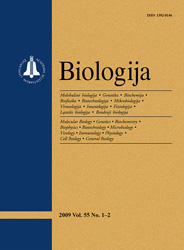Biologija / Biology
 ISSN 1392-0146 ISSN 2029-0578 (online) |
2007 m. Nr. 3 RAPD based study of genetic variation and relationships
among Lonicera germplasm accessions
Blue-berried honeysuckle (Lonicera caerulea L.) belongs to the Caprifoliaceae Juss. family section Isika Rehd., subsection Caeruleae Rehd. It produces extra-early ripening berries that are an excellent source of valuable phytochemicals and nutrients. Genetic variation and relationships among 39 L. caerulea accessions representing four subspecies, three cultivars, six genetic lines and one native L. xylosteum L. accession were characterized by the random amplified polymorphic DNA (RAPD) method. All the accessions were distributed into three groups according to their morphological and phenological characteristics. A total of 105 DNA fragments were scored after amplification of all DNA samples with 11 selected random primers; 83.9% of scored bands were polymorphic. Pair-wise genetic distance (GD) among L. caerulea accessions ranged from 0.0 to 0.366. Two accessions were identified as clones of the same genotype. All the accessions were grouped into three clusters. All accessions of L. caerulea were distinctly separated from L. xylosteum accessions. Our approach based on RAPD analysis was able to reveal genetic specificity only in the subspecies L. caerulea L. subsp. pallasii Ledeb. The study demonstrated that RAPD analysis is efficient for genotyping blue-berried honeysuckle accessions, and that DNA polymorphism significantly exceeds the morphological diversity of the samples studied.
Keywords: Lonicera caerulea L., RAPD, genetic relationship, genotyping, subspecies |
Issues:
2011 - Vol.57 No. 1, No. 2, No. 3 2010 - Vol.56 No. 1-4 2009 - Vol.55 No. 1-2, No. 3-4 2008 - Vol.54 No. 1, No. 2, No. 3, No. 4 2007 - Vol.53 No. 1, No. 2, No. 3, No. 4 2006 No. 1, No. 2, No. 3, No. 4 2005 No. 1, No. 2, No. 3, No. 4 2004 No. 1, No. 2, No. 3, No. 4 2003 No. 1, No. 2, No. 3, No. 4 2002 No. 1, No. 2, No. 3, No. 4 2001 No. 1, No. 2, No. 3, No. 4 |